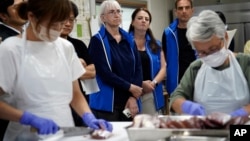An International Atomic Energy Agency inspection team Friday observed the preparation of fish samples for testing to assess the impact of treated nuclear wastewater released into the ocean from Japan's Fukushima nuclear power plant.
The IAEA team included independent scientists from China, South Korea and Canada, who observed at Japan's Marine Ecology Research Institute, in Chiba prefecture. Samples were sorted and prepared to be sent to laboratories in different countries for independent testing.
IAEA scientist Iolanda Osvath told reporters it was important the samples are sent to neighboring countries for testing so the data can be compared and each nation can trust each other's data.
The controversial release of the treated wastewater from the Fukushima Daiichi power plant began in August. Although IAEA scientists have insisted water samples taken have shown safe levels of radioactivity, the plan has been strongly opposed by neighboring countries.
China banned the import of Japanese seafood products as a result and hundreds of people have protested the plan in South Korea.
Japanese officials have said the release of the water, which is expected to take years, is necessary to fully decommission the plant.
The Fukushima plant became inoperable on March 11, 2011, when a 9.0-magnitude earthquake triggered a tsunami that swept across northeastern Japan before reaching Fukushima prefecture.
High waves knocked out the plant's power supply and cooling systems and led to a meltdown of three reactors, sending massive amounts of radiation into the air and forcing the evacuation of hundreds of thousands of residents, making it the world's worst nuclear disaster since the 1986 Chernobyl accident.
Some information for this report came from The Associated Press and Reuters.










